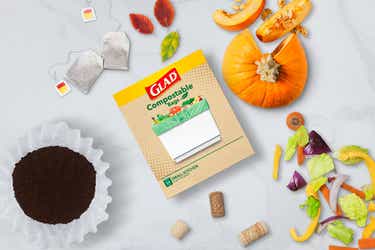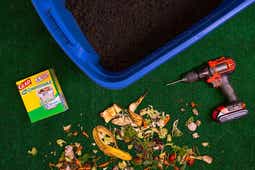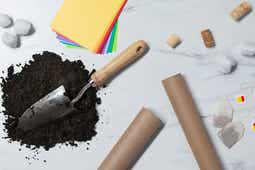What to Compost
Choosing the correct ingredients for your compost bin is crucial for it to function effectively. It’s important to strike the right balance between “green” nitrogen-rich material, like old food scraps and yard waste, as well as “brown” carbon-rich material like fallen leaves and old newspaper.
When properly prepared and in the right ratio, these materials create the perfect environment for bacteria and worms to thrive, turning what would be waste into valuable compost. Follow this list of compostable categories to ensure that your compost pile remains healthy and productive.
Composting guidelines vary by locality. Please check with your municipality to confirm acceptable items for composting. Glad® Composting bags are designed for use with municipal composting.
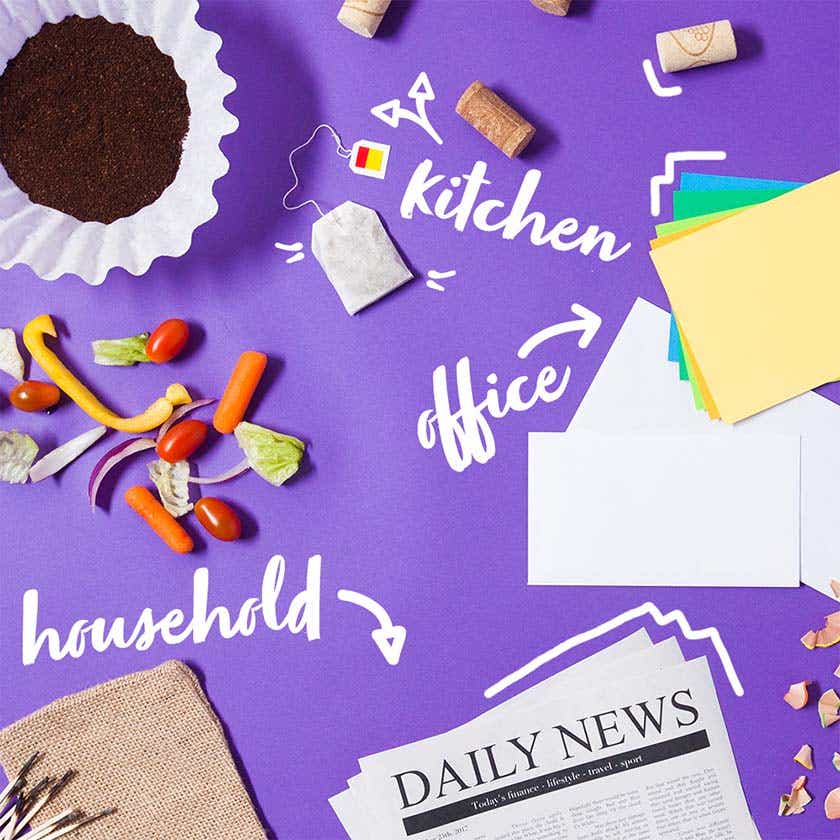
Green
The term “green” here refers to nitrogen-rich materials that provide important proteins and amino acids that are necessary for cell growth in the compost pile. Below is a list of “green” materials that you can include in your compost bin.*
*Please be sure to keep any perishable items isolated or frozen until pickup day in order to avoid nasty smells.
- Fruit & vegetable scraps
- Coffee grounds & filters
- Crushed egg shells
- Tea bags made with BPI certified compostable packaging & loose leaf tea
- Cooked rice and pasta
- Stale bread, tortillas and pitas
- Stale potato chips
- Spoiled tomato paste
- Spoiled tofu
- Seaweed
Brown
The term “brown” here refers to materials rich in carbon. These compost materials are important because they work as both the energy source and the basic building block of microbial cells within your compost. Here is a list of “brown” materials that you can include in your compost bin.
- Fallen leaves
- Woody prunings
- Untreated wood sawdust
- Black & white newspaper
- Used paper napkins (not soiled with grease or solvents)
- Used paper towels (not soiled with grease or solvents)
- Unwaxed cardboard (must rip into small pieces)
- Uncoated/unwaxed paper bag (must shred)
- Floor crumbs
- Stale cereal
- Cereal Box (must shred)
- Unwaxed used paper plates
- Nut Shells (except walnut shells)
- Wine corks
- Toothpicks
Special Situations
There are some items that may fall under the aforementioned “green” or “brown” categories but must be given special attention when being considered for compost. These items may disrupt your pile by inadvertently introducing a nasty fungus, foul odors or unwelcome critters into your backyard. Because every situation is unique, it’s best to leave these items out of your pile unless you are properly prepared for the consequences. Below is a list of materials that you should take special precautions with when adding them to your compost bin.*
*These items can be compostable depending on the compost program. Please contact your local municipality to learn more before composting.
- Jack-o’-lanterns (smashed)
- Young weeds
- Cooking oil
- Glue
- Latex rubber
- Meats & dairy (recommended to keep isolated or frozen until pickup day to avoid nasty smells)
What Not to Compost
Although most all living organisms can be composted, it’s best to leave out certain materials that attract rodents and create unpleasant smells. Here are the main categories of non-compostable items.
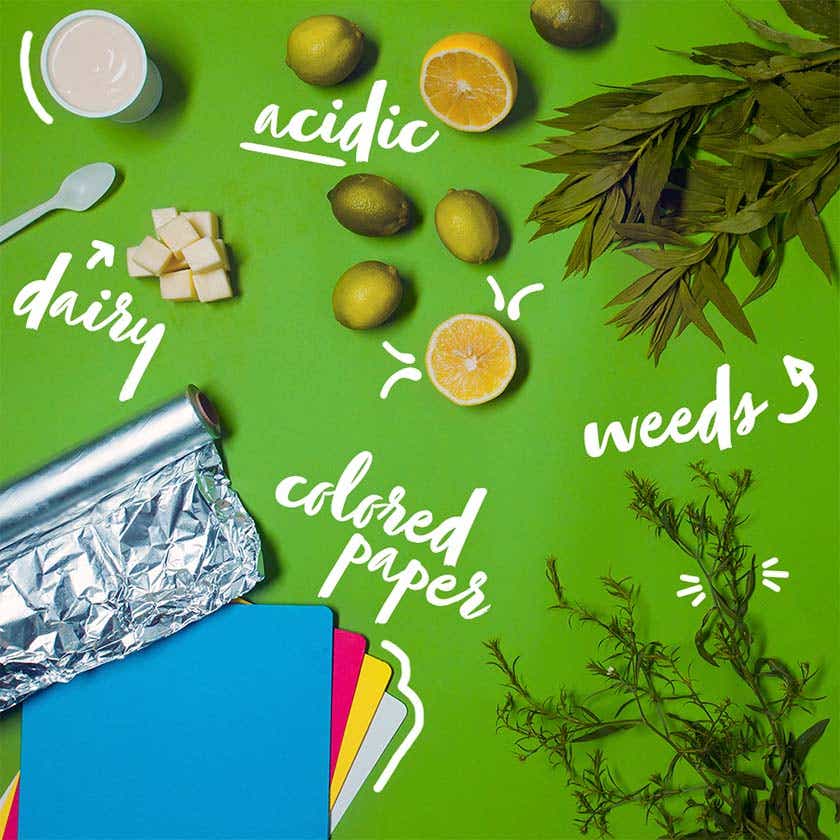
Meats
Similar to almost all living matter, meat is compostable, but beware, rotting meat can produce an offensive smell, which will attract pests from miles around. Many towns now offer curbside compost programs that pick up your food scraps and compost them for you. Contact your local curbside program if you plan on composting meat. If they accept it, be sure to keep it frozen before pickup day to avoid nasty smells.
Dairy
Like meat, dairy will spoil soon after it’s introduced into a compost pile. This may not attract as many pests, but it will certainly produce a strong odor that your neighbors won’t appreciate. The best place to put old dairy products is either down the drain if you are dealing with liquids or in the trash for solids. Contact your local curbside compost program if you decide to compost dairy. If they accept it, be sure to freeze or otherwise isolate the dairy in order to keep it from getting too stinky.
Pet Waste
Due to the carnivorous nature of most domestic house pets, their waste shouldn’t be included in your compost pile. Feces may spread diseases which can be dangerous to both plants and humans.
Anything Else
Composting can be a tricky process. Many materials we use every day have synthetic origins which are harmful to soil health if they are included in the compost process. Here is a list of miscellaneous materials you should be sure not to include in your compost pile.
- Grease
- Treated plywood
- Diseased plants
- Walnuts
- Glass
- Plastic
- Ceramics
- Pottery
Benefits of Composting
Composting creates a trickle-down effect that benefits those who use the compost as well as many other areas within the environment.
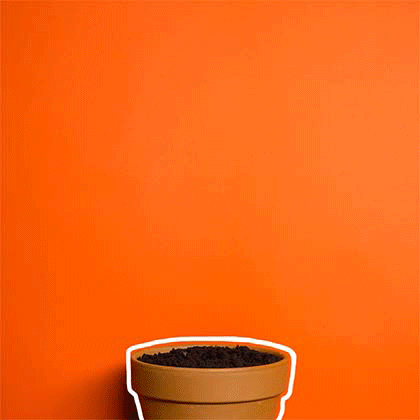
Reduces Waste
Surprisingly, organic waste, which includes yard and food waste, makes up 25% to 50% of total waste. The beauty of composting is that it significantly cuts down on overall household waste while producing a highly valued commodity.
When organic waste is put in the landfill, it undergoes a different decomposition process than what would normally occur in a compost pile. Because landfills are compacted to save space, they don’t allow any oxygen to interact with organic waste. As a result, bacteria actually breaks down this organic waste, which releases toxic gasses such as methane, a greenhouse gas, into the atmosphere.
Improves Soil Health
Adding compost or “black gold” to existing soil makes happy plants, improving their immune system, which helps them fight off attacks from other bugs and diseases. The use of compost reduces the need for harmful chemical fertilizers and in some cases, eliminates the need for them all together. On a larger scale, the benefits of compost have even been linked to higher yields in agricultural crops. Now just imagine what it can do for your backyard.
Conserves Resources
The act of composting is so ingrained in nature that once we restore this natural process, everything else seems to fall into place. Regularly adding compost to clay soil helps to break it up, which leads to less water run-off. Likewise, adding compost to sandy soils helps to reduce evaporation, leading to heartier soils.
It’s Rewarding
One of the most rewarding aspects of composting is being in charge of your very own ecosystem. In this ecosystem, you get to decide how fast or slow organisms move, the temperature at which they function, and how you want the finished product to perform.
Today’s on-the-go world leaves us little time to take a step back and smell the roses. It’s refreshing to slow down and reconnect with some of nature’s basic processes that go on behind the scenes, even at the microscopic level. This reconnection helps us get in touch with our place in the ever-spinning circle of life.


